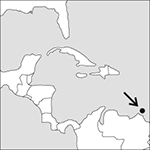
Source: MAPS IN MINUTES™ © RH Publications (1997)
Capital:
Port of Spain
Area:
5,128 sq km (1980 sq miles)
Population:
1,225,225 (2013 est)
Currency:
1 Trinidad and Tobago dollar = 100 cents
Religions:
Protestant 32.1%; Roman Catholic 21.6%; Hindu 18.2%; Muslim 5.0%
Ethnic Groups:
East Indian 35.4%; Black 34.2%; mixed 21.0%
Languages:
English (official)
International Organizations:
UN; Commonwealth; OAS; CARICOM; Non‐Aligned Movement; WTO
An island country in the south‐east corner of the Caribbean Sea, the larger island, Trinidad, lying only 11 km (7 miles) off the northern coast of South America.
Physical
Trinidad measures about 80 km (50 miles) by 60 km (37 miles). In the south‐west is the great Pitch Lake, a basin of bitumen; and across the north is a range of low mountains. The densely forested hills of Tobago, to the north‐east, are the ridge of an otherwise submerged mountain range.
Economy
The economy is dominated by oil and gas, which constitute two-fifths of GDP and four-fifths of exports. Other export industries include methanol, ammonia, urea, steel products, and beverages. With declining oil and gas reserves, tourism, agriculture, information and communications technology, and shipping are being encouraged.
History
The islands were originally inhabited by Arawak and Carib Indians. Trinidad was discovered by Columbus in 1498 during his third voyage. Trinidad was claimed by Spain but left to its indigenous Caribs until 1532, when settlement was begun. As it lacked precious metals it remained largely ignored until 1595, when Sir Walter Raleigh landed there for ship repairs and sacked the newly founded town of San José; the Dutch raided it in 1640, and the French in 1677 and 1690. Sugar and tobacco plantations were established in the 17th century, worked by imported African slaves. In 1797, during war between England and Spain, a British squadron entered the Gulf of Paria but met little resistance before the island surrendered. In 1802 it was officially ceded to Britain under the Treaty of Amiens. In 1962, the country became an independent member of the British Commonwealth and, in 1976, a republic. The first Prime Minister of the new republic was Eric Williams, founder of the People’s National Movement (PNM). Trinidad’s first President, Ellis Clarke, was succeeded in 1987 by Noor Mohammed Hassanali, who was in turn succeeded in 1997 by Arthur N. Robinson. In 2001 there was a constitutional crisis when elections produced a tie in parliament; the President appointed Patrick Manning of the PNM as Prime Minister. He was confirmed in office by another election in 2002 and re-elected in 2007. However, Manning’s decision to call an early election in 2010 backfired: a centre-left coalition was victorious and Kamla Persad-Bissessar became Trinidad and Tobago’s first woman Prime Minister. Her government faced complaints about corruption and the failure to curb violent crime. The 2015 general election resulted in victory for the PNM, and its new leader, Keith Rowley became Prime Minister. The fall in the price of oil has had a significant impact on the economy and government revenues, and at the end of 2015 the economy moved into recession.
- transcendental analytic
- transcendental argument
- transcendental idealism
- transcendentalism
- transcendental number
- transconductance amplifier
- transconductance(symbol: gm)
- transcriptase
- transcription
- transcription factor
- transcriptome
- transcriptomic
- transcurrent fault
- transducer
- transducin
- transduction
- transductor
- trans-Earth injection
- transect
- trans effect
- trans fatty acid
- transfection
- transferability
- transferase
- transfer cell